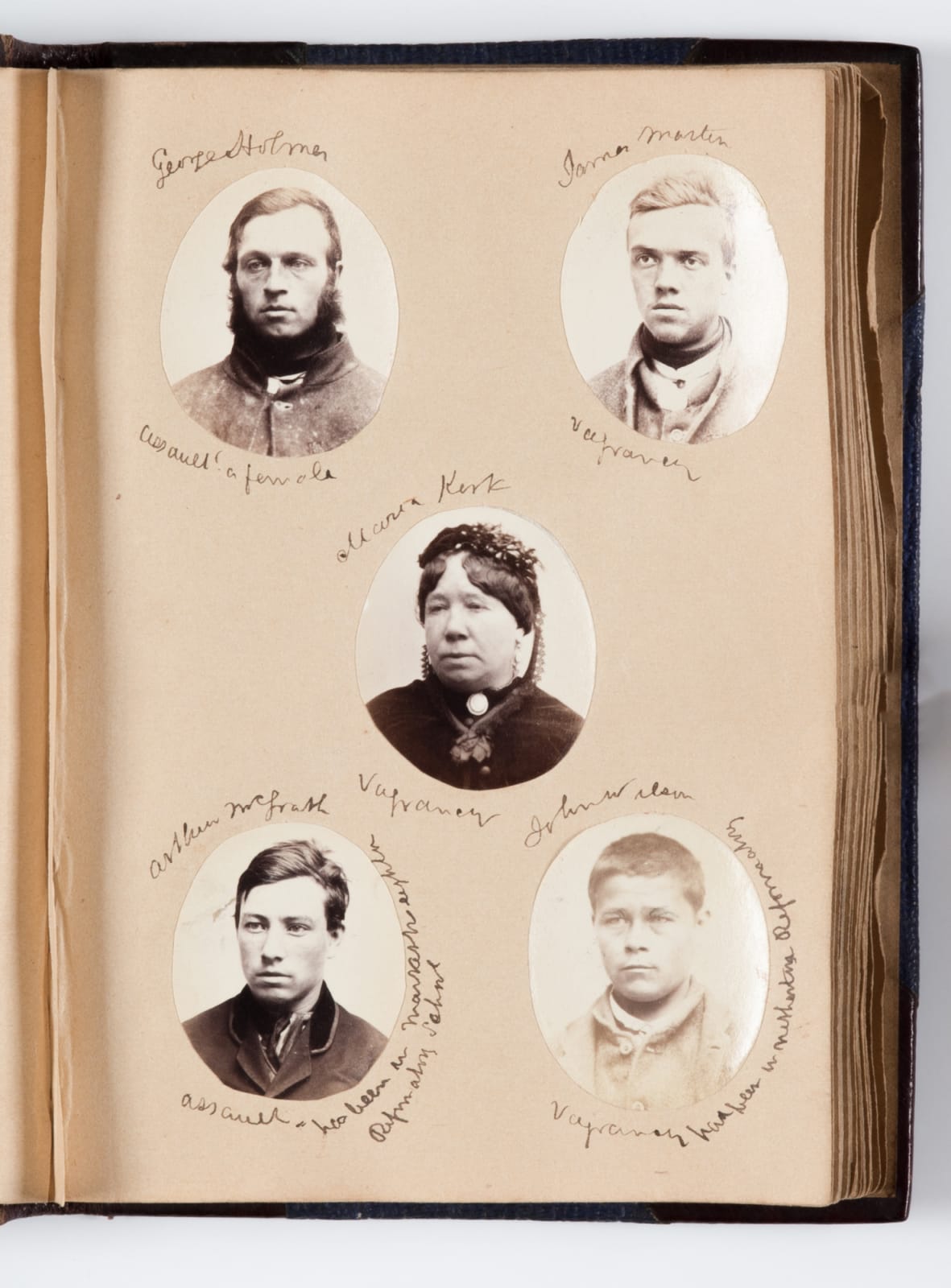Alfred Shepherd
Trio of Pre-Bertillon Mugshot albums , 1869-77
Photo albums (3); Albumen prints (435)
Each overall 5 1/2 x 3 1/2 inches
Sold
Further images
-
(View a larger image of thumbnail 1
)
![[Rodney King], Dramatic Aerial Views of the Los Angeles Uprising, 1992](https://artlogic-res.cloudinary.com/w_150,h_150,c_fill,f_auto,fl_lossy,q_auto/artlogicstorage/dollc/images/view/57fd07f51bf4ff138d2fbf2ce31f1bbcj/daniel-oliver-alfred-shepherd-trio-of-pre-bertillon-mugshot-albums-1869-77.jpg)
-
(View a larger image of thumbnail 2
)
![[Rodney King], Dramatic Aerial Views of the Los Angeles Uprising, 1992](https://artlogic-res.cloudinary.com/w_150,h_150,c_fill,f_auto,fl_lossy,q_auto/artlogicstorage/dollc/images/view/ecdb649002907210f9ea7599ef72f647j/daniel-oliver-alfred-shepherd-trio-of-pre-bertillon-mugshot-albums-1869-77.jpg)
-
(View a larger image of thumbnail 3
)
![[Rodney King], Dramatic Aerial Views of the Los Angeles Uprising, 1992](https://artlogic-res.cloudinary.com/w_150,h_150,c_fill,f_auto,fl_lossy,q_auto/artlogicstorage/dollc/images/view/ea5b1de11eabd7b08724df4b42627141j/daniel-oliver-alfred-shepherd-trio-of-pre-bertillon-mugshot-albums-1869-77.jpg)
-
(View a larger image of thumbnail 4
)
![[Rodney King], Dramatic Aerial Views of the Los Angeles Uprising, 1992](https://artlogic-res.cloudinary.com/w_150,h_150,c_fill,f_auto,fl_lossy,q_auto/artlogicstorage/dollc/images/view/82843c6c699e6335df92678dfef5ecc6j/daniel-oliver-alfred-shepherd-trio-of-pre-bertillon-mugshot-albums-1869-77.jpg)
-
(View a larger image of thumbnail 5
)
![[Rodney King], Dramatic Aerial Views of the Los Angeles Uprising, 1992](https://artlogic-res.cloudinary.com/w_150,h_150,c_fill,f_auto,fl_lossy,q_auto/artlogicstorage/dollc/images/view/76b5bb1bb88b6db9f39fbd89545a9642j/daniel-oliver-alfred-shepherd-trio-of-pre-bertillon-mugshot-albums-1869-77.jpg)
-
(View a larger image of thumbnail 6
)
![[Rodney King], Dramatic Aerial Views of the Los Angeles Uprising, 1992](https://artlogic-res.cloudinary.com/w_150,h_150,c_fill,f_auto,fl_lossy,q_auto/artlogicstorage/dollc/images/view/58ebcab026ee7ea0447d5eb6eb966600j/daniel-oliver-alfred-shepherd-trio-of-pre-bertillon-mugshot-albums-1869-77.jpg)
-
(View a larger image of thumbnail 7
)
![[Rodney King], Dramatic Aerial Views of the Los Angeles Uprising, 1992](https://artlogic-res.cloudinary.com/w_150,h_150,c_fill,f_auto,fl_lossy,q_auto/artlogicstorage/dollc/images/view/ae2271bb950380ac5bb75dc71a9ee8f1j/daniel-oliver-alfred-shepherd-trio-of-pre-bertillon-mugshot-albums-1869-77.jpg)
-
(View a larger image of thumbnail 8
)
![[Rodney King], Dramatic Aerial Views of the Los Angeles Uprising, 1992](https://artlogic-res.cloudinary.com/w_150,h_150,c_fill,f_auto,fl_lossy,q_auto/artlogicstorage/dollc/images/view/0cf41ca3501e02e5404222f48ca8ee3cj/daniel-oliver-alfred-shepherd-trio-of-pre-bertillon-mugshot-albums-1869-77.jpg)
-
(View a larger image of thumbnail 9
)
![[Rodney King], Dramatic Aerial Views of the Los Angeles Uprising, 1992](https://artlogic-res.cloudinary.com/w_150,h_150,c_fill,f_auto,fl_lossy,q_auto/artlogicstorage/dollc/images/view/d10c8bb565103c1cd50df376c99379e4j/daniel-oliver-alfred-shepherd-trio-of-pre-bertillon-mugshot-albums-1869-77.jpg)
-
(View a larger image of thumbnail 10
)
![[Rodney King], Dramatic Aerial Views of the Los Angeles Uprising, 1992](https://artlogic-res.cloudinary.com/w_150,h_150,c_fill,f_auto,fl_lossy,q_auto/artlogicstorage/dollc/images/view/97a5dff67dd9f5039552cb8ece8997d4j/daniel-oliver-alfred-shepherd-trio-of-pre-bertillon-mugshot-albums-1869-77.jpg)
A compelling suite of three 19th Century pocket-sized photo albums kept (and possibly photographed) by Alfred Shepherd, the Governor of the East Riding House of Correction at Beverley, East Yorkshire....
A compelling suite of three 19th Century pocket-sized photo albums kept (and possibly photographed) by Alfred Shepherd, the Governor of the East Riding House of Correction at Beverley, East Yorkshire.
The trio comprises a total of 435 objective photographs portraying a grisly bunch of Victorian criminals, most identified by name, crime, and duration of incarceration. With the majority of the offenders serving brief stints for Larceny, there are those accused of other felonies such as sheep stealing (worthy of 16 months), perjury, embezzlement (12 months), robbery, assault, vagrancy, “rogue & vagabond,” cruelty to a sheep, malicious wounding, and one woman charged with the “Murder of Lendley Hill.”
The Dickensian bunch are mostly middle-aged males boasting thick mutton-chops or chin-strap beards (in true period fashion) however, a considerable portion of the convicted are women and children, the latter often sentenced to time at reformatory schools. The more serious of the juvenile offenders were sent to the Akbar, a reformatory ship moored off Rock Ferry, Birkenhead. The former naval boat could accommodate 200 boys, age 14-16, whom had been committed to detention of at least five years.
The neatly-bound albums were compiled at three separate times over the course of an eight year period between 1869 and 1877 (1869-70; “latter part” of 1871; and June 1876-July 1877.) The prison is said to have closed in 1878 after it was handed over to the British Home Office Prison Department. Not long after this, Shepherd died in 1882.
The widely-recognized and systematic approach to “mug shots” was not developed until 1888 when Alphonse Bertillon, a French police officer, standardized the process of photographing criminals. Prior to this, law-enforcement relied solely on names (at a time when changing one’s name was not exactly difficult), and non-standardized photographs, if local authorities even chose to keep this sort of record. The present grouping of albums is an extremely fine example of photographic record-keeping, and the consistency in the style and quality of portraiture is impressively competent.
The trio comprises a total of 435 objective photographs portraying a grisly bunch of Victorian criminals, most identified by name, crime, and duration of incarceration. With the majority of the offenders serving brief stints for Larceny, there are those accused of other felonies such as sheep stealing (worthy of 16 months), perjury, embezzlement (12 months), robbery, assault, vagrancy, “rogue & vagabond,” cruelty to a sheep, malicious wounding, and one woman charged with the “Murder of Lendley Hill.”
The Dickensian bunch are mostly middle-aged males boasting thick mutton-chops or chin-strap beards (in true period fashion) however, a considerable portion of the convicted are women and children, the latter often sentenced to time at reformatory schools. The more serious of the juvenile offenders were sent to the Akbar, a reformatory ship moored off Rock Ferry, Birkenhead. The former naval boat could accommodate 200 boys, age 14-16, whom had been committed to detention of at least five years.
The neatly-bound albums were compiled at three separate times over the course of an eight year period between 1869 and 1877 (1869-70; “latter part” of 1871; and June 1876-July 1877.) The prison is said to have closed in 1878 after it was handed over to the British Home Office Prison Department. Not long after this, Shepherd died in 1882.
The widely-recognized and systematic approach to “mug shots” was not developed until 1888 when Alphonse Bertillon, a French police officer, standardized the process of photographing criminals. Prior to this, law-enforcement relied solely on names (at a time when changing one’s name was not exactly difficult), and non-standardized photographs, if local authorities even chose to keep this sort of record. The present grouping of albums is an extremely fine example of photographic record-keeping, and the consistency in the style and quality of portraiture is impressively competent.
1
of
52









